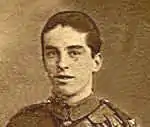Thomas Bryan | |
|---|---|
 | |
| Born | 9 January 1897[1] Dublin, Ireland |
| Died | 14 March 1921 (aged 24)[2] Mountjoy Prison, Dublin, Ireland |
| Cause of death | Execution by hanging |
| Other names | Thomas Brien[1][3] |
| Occupation | Electrician |
| Known for | Executed IRA volunteer : One of The Forgotten Ten |
Thomas Bryan (9 January 1897 – 14 March 1921) was an Irish republican and member of the Irish Republican Army who was one of six men hanged in Mountjoy Prison on 14 March 1921.
Background
He was born at 30 North Brunswick Street, Dublin on 9 January 1897.[1] His birth was registered as Thomas, son of James Brien, a labourer, and Mary Brien, née Caffrey.[1] In the early 1900s, he and his family lived in North King Street, Dublin.[4][5] He was an experienced IRA Volunteer and a member of the Dublin Brigade's Active Service Unit.[6][7] In 1917, he took part in the hunger strike in Mountjoy in which Thomas Ashe died. By 1920,[3] Bryan was living at 14 Henrietta Street, Dublin and was an electrician by trade.[2][8] He married Annie Glynn at St. Michan's Catholic Church, Dublin on 28 November 1920.[3]
His great-nephew is English singer Boy George.[9]
Trial and execution
He was tried by court-martial on 24 February 1921 for his part in an attempted ambush at Drumcondra on 21 January 1921.[10] Found guilty of high treason, he was hanged, aged 24, along with Frank Flood at 8am on 14 March 1921.[10] Four other men had been hanged earlier on the same day: Thomas Whelan and Patrick Moran at 6am and Patrick Doyle and Bernard Ryan at 7am.[10][11] It was reported that a crowd of over 20,000 people assembled outside Mountjoy on the morning of the executions.[10] Work was also suspended throughout the city following a call from the Irish Labour Party.[11]
Re-interment
He is one of a group of men hanged in Mountjoy Prison in the period 1920–1921, commonly referred to as The Forgotten Ten. On 14 October 2001, he and the other nine, including Kevin Barry, were exhumed from their graves in the prison and given a full state funeral.[12] He is now buried in Glasnevin Cemetery, Dublin.[13]
In March 2023 a plaque was unveiled by Dublin City Council at his old residence, 14 Henrietta Street.[14]
References
- 1 2 3 4 "Births in the Superintendent Registrar's District of North Dublin, 1897" (PDF). irishgenealogy.ie. Entry Numbers 154–163. Retrieved 27 July 2021.
- 1 2 "Deaths in the Superintendent Registrar's District of Dublin, 1921" (PDF). irishgenealogy.ie. Entry Numbers 372–380. Retrieved 27 July 2021.
- 1 2 3 "Marriages in the Superintendent Registrar's District of Dublin, 1920" (PDF). irishgenealogy.ie. Entry Numbers 88–91. Retrieved 27 July 2021.
- ↑ "Residents of a house 141.1 in King Street North (Inns Quay, Dublin)". census.nationalarchives.ie. 31 March 1901. Retrieved 29 July 2021.
- ↑ "Residents of a house 141.1 in King Street, North (Arran Quay, Dublin)". census.nationalarchives.ie. 2 April 1911. Retrieved 29 July 2021.
- ↑ "The Forgotten Ten: Part 4: 'Down Into the Mire'". thewildgeese.irish. 19 January 2013. Retrieved 29 July 2021.
- ↑ "The Forgotten Ten: Part 5: 'England Executes Prisoners of War'". thewildgeese.irish. 19 January 2013. Retrieved 29 July 2021.
- ↑ Fallon, Donal (5 March 2021). "Remembering Thomas Bryan". 14henriettastreet.ie. Retrieved 29 July 2021.
- ↑ "Boy George: 'My Irish family's story is like a great Irish song, a lament'".
- 1 2 3 4 Fielding, Steve (1995). The Hangman's Record 1900–1929. Vol. 2. Beckenham: Chancery House Press. p. 183. ISBN 0-900246-77-4.
- 1 2 "Six Irishmen Die On Dublin Gallows As Crowd Pray" (PDF). The New York Times. 15 March 1921.
- ↑ O'Halpin, Eunan & Ó Corráin, Daithí (2020), The Dead of the Irish Revolution. Yale University Press, 2020. p. 338-339, ISBN 978-0-300-12382-1
- ↑ "History". Nga.ie. Archived from the original on 20 November 2007. Retrieved 2 November 2008.
- ↑ Blaney, Amy. "Plaque unveiled to Thomas Bryan, one of the 'Forgotten 10' during War of Independence". Irish Independent.